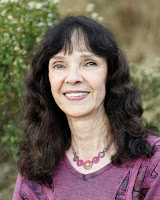LUCILLE LANG DAY
The talented, generous writer Lucille Lang Day is author most recently of Birds of San Pancho and Other Poems of Place (Blue Light Press: First World Publishing, 2020). She contributes to the literary community in so many ways. First, she is publisher of Scarlet Tanager Press, an independent press that publishes Indigenous and other writers. She edits anthologies, including Red Indian Road West: Native American Poetry from California (co-edited with Kurt Schweigman, Scarlet Tanager) and Fire and Rain: Ecopoetry of California (co-edited with Ruth Nolan. She organizes readings, supports Scarlet Tanager authors at the Associated Writing Programs conference, and appears at events. In addition to her support for others, her own poetry is dynamite. The title poem of her latest book Birds of San Pancho begins:
belting its exuberant song
above
the dusty, cobblestone street.
The bird
is masked like a raccoon, its
breast
yellow as the butterflies that
flit
amid hibiscus and
bougainvillea. . . .
The poet describes the scene with
bold brushstrokes, unafraid of interpretive adjectives like “exuberant” and a vivid
comparison of a bird’s head markings to a raccoon’s mask. She is in control of
syntax as she effortlessly progresses through the poem. Her balance of
description and reflection keeps the poem interesting as it builds to its
ending point:
Later, at the lagoon, a great
blue heron,
a little blue heron, a green
heron,
a night heron, two great
egrets, eight
snowy egrets and twenty cattle
egrets
gather while brown pelicans
dive
for fish and the sun’s bright
disk sinks
into the sea. When it
disappears,
the egrets rise in groups and
pairs
to settle in two coconut palms
for the night. Oh, to sit up
there too—
safe, having eaten my
fill—with
folded wings, watching over
creation.
Focus is on the birds and nature’s
patterns, not the poet’s life and ego—until the very end when the poet enters
into the moment to share, not to overwhelm the entire poem. Her “Vincent’s
Bedroom at Arles” is a perfect double ekphrastic poem—about the painting and
about the physical room itself—and then it turns out the Arles citizenry
recreated this room because the original was destroyed during World War II. This gives Day occasion to ponder
intersections of fiction and reality on many levels, made (seemingly)
effortless in her poet’s spell. “At Lake Tahoe” is another well calibrated poem
about the poet’s Wampanoag ancestry set side-by-side with California Indigenous
people of this place, the Washoes. It ends:
Yet in summer Washoes still do the Pine Nut Dance
and Wampanoags do the Grass Dance to keep the world
in balance and remind us that the Earth is living, every
rock is sacred, and every tree and salmon has a soul. (79)
Day is able to tie two coasts together in this ending—the Massachusetts
Wampanoags and the California Washoes. This understanding of unities is one of
the pleasures of the collection. Day has a science Ph.D., and also M.F.A. in
creative writing. She puts these two perspectives to good use in her writing.
It is precise, complete, and transformative.
#
Interview with SF Review of Books Zara's
Blog (zararaabblog.blogspot.com)
Poem by Lucille Lang dYetay, Valpraiso, “Birds of San
Pancho”
Poem by Lucille Lang Day Poetry
Foundation, “Tooth Painter,”
Video of Lucille Lang Day Berkeley Public Library
poetry reading,
Video of Lucille Lang Day “How
to Publish a Memoir,”
Lucille Lang Day is the author of seven
full-length poetry collections and four poetry chapbooks. Her latest collection
is Birds of San Pancho and Other Poems of Place (Blue Light
Press, 2020). She has also edited the anthology Poetry and Science:
Writing Our Way to Discovery, and she coedited Fire and Rain:
Ecopoetry of California and Red Indian Road West: Native
American Poetry from California. Other publications are two children’s
books and a memoir, Married at Fourteen: A True Story. Her many
honors include the Blue Light Poetry Prize, two PEN Oakland-Josephine Miles
Literary Awards, the Joseph Henry Jackson Award, and eleven Pushcart Prize
nominations. She holds an M.F.A. in creative writing from San Francisco State
University, an MA in zoology, and a Ph.D. in science/mathematics education from
the University of California at Berkeley. She lives in Oakland, California. She
is of Wampanoag, British, and Swiss/German descent. www.lucillelangday.com
Denise Low, Kansas Poet Laureate 2007-09, won the
Editor’s Choice Red Mountain Press Poetry Award for Shadow Light.
Other publications are memoirs The Turtle’s Beating Heart: One Family’s
Story of Lenape Survival (U. of Nebraska Press,) and Jigsaw
Puzzling: Essays in a Time of Pestilence (Meadowlark, Sept.
2022); Wing (Red Mountain, Hefner Heitz Award finalist); Casino
Bestiary (Spartan); and Jackalope (fiction, Red
Mountain). She is co-author of Northern Cheyenne Ledger Art by Fort
Robinson Breakout Survivors (U. of Nebraska Press, Ks. Notable Book).
Her PhD in literature and creative writing is from the University of Kansas,
and her MFA is from Wichita State. At Haskell Indian Nations University, she
founded the creative writing program. She teaches for Baker University’s School
of Professional and Graduate Studies. Board memberships include Indigenous
Native Poets (In-Na-Po) and Associated Writers and Writing Programs (past
president and contributing editor). Her heritage includes British Isles,
German, and Lenape/Munsee (Delaware). She lives in California’s Sonoma County.www.deniselow.net
